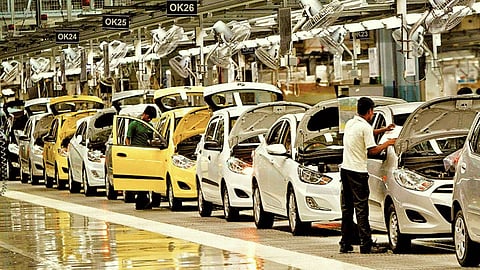- Commentary
- History Vignettes
- Notes on Culture
- Dispatches
- Podcasts
- Indian LanguagesIndian Languages
- Support

India’s automobile Sector is facing big trouble with its sales. Available figures show that the sales of large commercial and passenger vehicles are plummeting. This has forced many manufacturers to cut down or even halt production till dealer inventories are cleared. However, this medicine doesn’t seem to be working. The Auto sector continues to shrink further thereby threatening jobs across the industry. The Automotive Component Manufacturers Association of India has warned that nearly a million jobs could be lost if the such a situation persists.
Finance minister Nirmala Sitharaman said that the auto sector’s downtrend has to do with Indian millennials’ preference for Ola and Uber. There is a legitimate case to be made for the trend of millennials preferring cab aggregators instead of a monthly commitment to pay hefty EMIs, higher insurance and expensive fuel costs. The FM also cited the heavy use of Metros as another reason for millennials not buying cars.
Ola and Uber have been around since the last six or so years in India. However, during this same period, the auto industry also witnessed very good sales and there used to be waiting periods for certain brands of automobiles. Maruti Suzuki India’s Executive Director (Marketing and Sales) Shashank Srivastava stated that in “India, 46 per cent of the car buyers are first time users. It is an aspirational behaviour. People may use public transport like Ola and Uber to go to offices on weekdays, but still they buy a vehicle for the weekend outings with the family”.
Ride growth rates of both the cab aggregators have declined to 4.5 per cent by June 2019. In 2016, the daily growth in ride rates was 90 per cent, which declined to 57 per cent in 2017 and further down to 20 per cent in 2018. Both Ola and Uber have cut down driver incentives substantially in order to cut down losses or to show profits. “The market is facing a saturation for point-to-point cab-hailing,” said Jaspal Singh, cofounder, Valoriser Consultants, a transportation sector focused consultancy (source The Economic Times). Commercial vehicle registrations have fallen, which reflect on the cab aggregators’ numbers. In Maharashtra, 66,683 tourist cabs were registered in 2017-18 and such numbers fell to a whopping 24,386 in 2018-19 (according to data on the state transport department website). These vehicles were mostly engaged with Ola and Uber.
So that begs the following question: if substantial numbers of people were routinely using these cab services to commute to their workplace, why is there a decline in growth rates of these service providers and why haven’t they become a profitable business so far? Do we attribute it to more usage of Metros and other means of public transport? Going by the numbers, we can consider the example of daily Metro users. This stands at 450,000 in Bengaluru and 5.5 million in Delhi (as per Metro official numbers). The evidence is inescapable: there has been a marked surge in the number of people who are using such public transport systems to commute daily. The usage of Metro especially, has been on the steady rise in most cities where it operates.
So what seems to have happened in the past few years that has apparently worsened the downturn?
We can look at factors such as an overall, global economic slowdown which has impacted India as well. This is most visibly reflected in the six per cent GDP figure and a slowdown in jobs. But in the specific case of the automobile sector, the obvious factor seems to be ignored: high cost of vehicle ownership, especially in India. Indeed, the cost of vehicles have been on the rise year after year coupled with escalating insurance costs.
The NBFC (a.k.a. shadow banking) crisis has also made car loans scarce. To put this in perspective, in India, NBFCs have funded almost 55 – 60 per cent of commercial vehicles, 30 per cent of passenger cars and nearly 65 percent of the two-wheelers, according to the rating agency ICRA. Higher cost of vehicle usage (fluctuating oil prices, parking costs escalating in commercial spaces, etc), breakdown of urban infrastructure leading to more commuting time in cities are also among the other major contributors to the slowdown in the auto sector. A slow and sluggish rural income growth is also affecting the auto sector as almost 35 per cent demand is from the rural sector. To make matters worse, the banks have trimmed down their lending to the auto sector.
In the overall reckoning, the issue is that of multiple factors coming together and not a simplistic reading that the slowdown has occurred only because of millennials using Uber and Ola. It is an issue of cheaper acquisitions and manageability of one’s aspirations, access to a cheaper, faster, convenient way of daily commute. It is also an issue of not spending freely during this economic downtrend and trying to save up for rougher times. This downtrend should have been anticipated and foreseen by both the auto Sector and government. Equally, appropriate planning, reduction in costs should have been done in advance instead of over production and piling up of inventory.
The Dharma Dispatch is now available on Telegram! For original and insightful narratives on Indian Culture and History, subscribe to us on Telegram.
